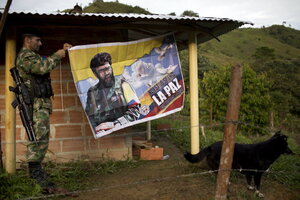Colombia creates peace before ending a war
To end its long conflict, Colombia’s government and rebel leaders first had to strike agreements on what peace would look like. Only now have they agreed on a cease-fire. It is a novel approach to end other wars.

In this Jan. 3, 2016 photo, Orlando, a rebel fighter for the the Revolutionary Armed Forces of Colombia or FARC, hangs a banner featuring the late rebel leader Alfonso Cano with a message that reads in Spanish: "Our dream is peace with social justice," in their hidden camp in Antioquia state, in the northwest Andes of Colombia. The Colombian government and leftists FARC rebels said Wednesday, June 22, 2016, that they have reached a deal on a bilateral cease-fire that would be the last major step toward ending one of the world’s longest wars. President Santos will travel to Cuba Thursday for the announcement with the FARC.
AP Photo
Wars end when the fighting stops, right? And that is called peace?
Not so in the case of Colombia’s 52-year-long conflict between the government and a Marxist rebel group called the Revolutionary Armed Forces of Colombia (FARC). Over the past four years, even as they clashed in war, the two sides have been building peace through a series of negotiated agreements on specific issues, such as rural reform. Only on Wednesday did they finally agree on the terms of a military cease-fire.
There’s a lesson for other world conflicts in this “peace first” approach. It is that peace must be seen not merely as the absence of war but as a tangible reality. For Colombia that reality has been designed through difficult talks to include interim pacts on truth-telling about past abuses, a measure of justice for victims, an eventual coexistence between old foes, and broad economic and social reforms.
It may sound odd, but the negotiators describe the approach this way: “Fight the war as if there is no peace process and conduct the peace process as if there is no war.” In other words, protect the peace process from flare-ups in the war that might derail it.
What has been key to this mutual building of peace prospects?
Both sides at the negotiating table really began to bond and create trust when they recognized a common experience: that many of their own family, friends, and colleagues had been innocent victims of this long war.
In fact, a dozen victims were present at the talks, which have been held in Cuba. Some 7. 9 million victims organized themselves through elections to create a representative group from both sides. Their presence, along with their demands for peace, accountability, and reparations, could not be ignored.
The victims’ pleas helped create a mood of humility, and even one apology. A rebel commander recently apologized to a village where a massacre took place after rebel weapons hit a church full of people.
Wednesday’s cease-fire agreement, which includes terms for demobilizing FARC’s 8,000 to 10,000 rebels, indicates that negotiations for a full and final peace agreement could wrap up in coming weeks. The complete set of pacts will then be put to a referendum. Once approved, implementation starts.
Under the rules of the talks, nothing is agreed until everything is agreed. Each side must know first what peace will look like to them. Then the war can stop. If this approach works, Colombia will have created a model worth trying to end other wars.

